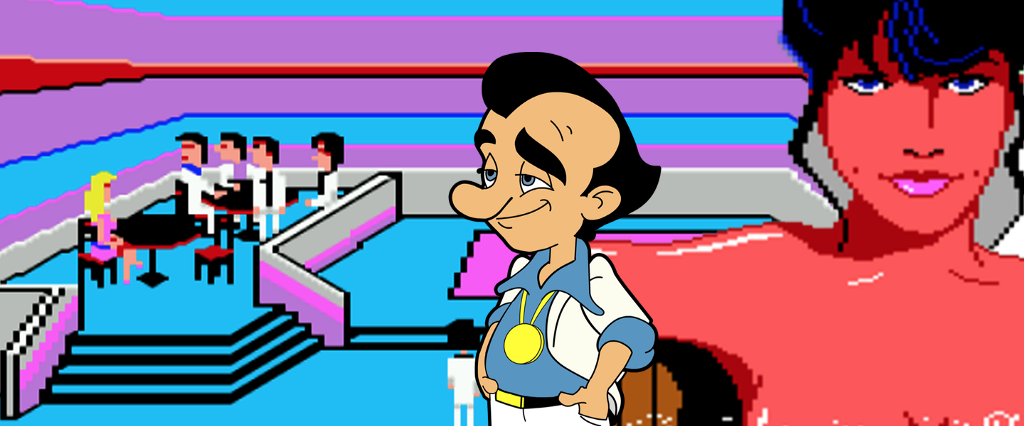If you happened to flip through a PC gaming magazine in the late 1980s or early 1990s, you would’ve probably seen an ad for a game called Leisure Suit Larry, or one of its many sequels. It was a graphic adventure game first released in 1987 with the primary goal of helping its protagonist get laid. Since most games then leaned heavily into cartoon violence, Larry’s sexual innuendo stood out. To young boys at the time, it had the mystique of a shrink-wrapped Playboy in a convenience store.
The game was an initial flop, largely because major retail stores like RadioShack were hesitant to sell an “adult” game. But because of word-of-mouth, sales eventually picked up, and it became a bestseller, resulting in a series of popular sequels. It also inspired blatant ripoffs, even as recently as 2004 with a game called Fuck Quest II. In fact, it became one of the most pirated games of all time, and due to a virus hidden in a few blackmarket copies, caused widespread problems in European banking terminals.
Considering its premise, the game itself was surprisingly tame. (See for yourself: It’s available to play for free over at the Internet Archive.) But this didn’t hurt sales. It gradually became one of the best-selling erotic adventure games of all time, and it remains one of the few dating simulations to ever crack into the mainstream in the U.S.
For those unfamiliar, dating sims are, broadly, games where the player guides a character on a romantic quest. The actual gameplay varies — some are simple choose-your-own-adventure games; others are conversation-based, in which a player has to navigate complex dialogue trees and successfully flirt; yet others are essentially puzzle games with soft and hardcore pornographic elements. The genre is male dominated, but not always (Boyfriend Maker), and mostly unpopular outside of Japan (save for the Larry series and sections of Stardew Valley).
There are also a number of sub-genres, including sex games, where the player attempts to get someone to climax. These were usually Flash-based, peaked in the 2000s, crudely animated and sometimes involved furries. Other spin-offs include Hatoful Boyfriend, a dating sim starring pigeons, and Angela Washko’s brilliant anti-dating sim The Game: The Game, a scathing satire in which players try to fend off aggressive pickup artists in a bar. It helps to think of the whole dating sim genre, and its various subgenres and spin-offs, as basically Harlequin romance novels for nerdy men.
For all of this, blame Larry.
The Origins of ‘Softporn’ Gaming
Larry’s inclusion in Sierra’s catalogue — a publishing company known for mostly family-friendly fantasy and sci-fi adventure fare — was odd. But it wasn’t the first such game. Back in 1979, Sierra published a text-only adventure game called Softporn Adventure. It was created by a self-taught programmer named Chuck Benton, who at the time worked for a company that developed flight simulators. It was a primitive text-based adventure game, and likely the very first dating sim. It was navigated using only text commands, which are figured out mostly through guesswork. For example, the game opens with the following paragraph:
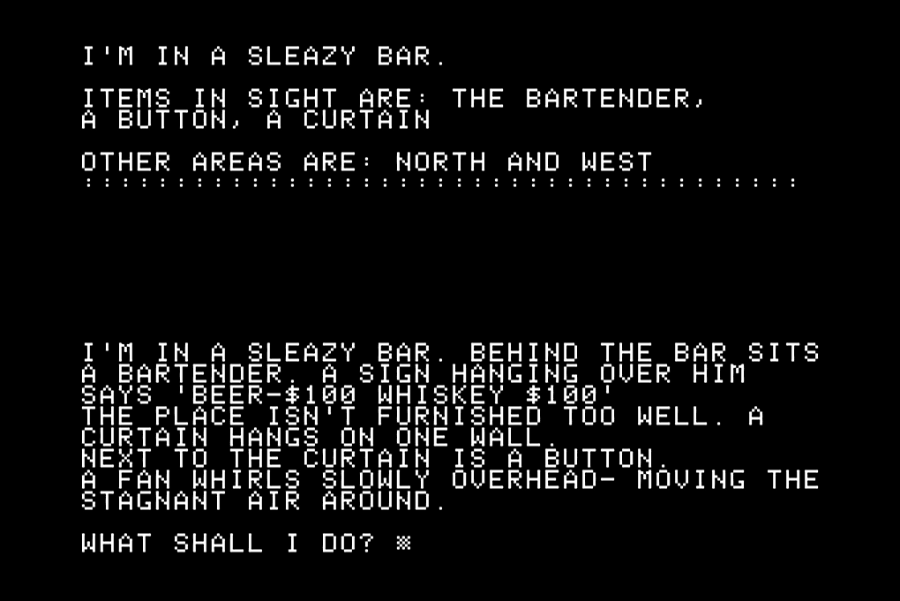
To move forward to the next scene, the player must enter >ORDER WHISKEY. (The final command of the game is (spoiler alert?) >SCREW GIRL.) Despite its relative difficulty, it sold about 25,000 copies, according to Sierra founder Ken Williams. This is an impressive figure, considering there were only about 100,000 Apple II owners at the time. Its success could probably be attributed to its enticing cover art.
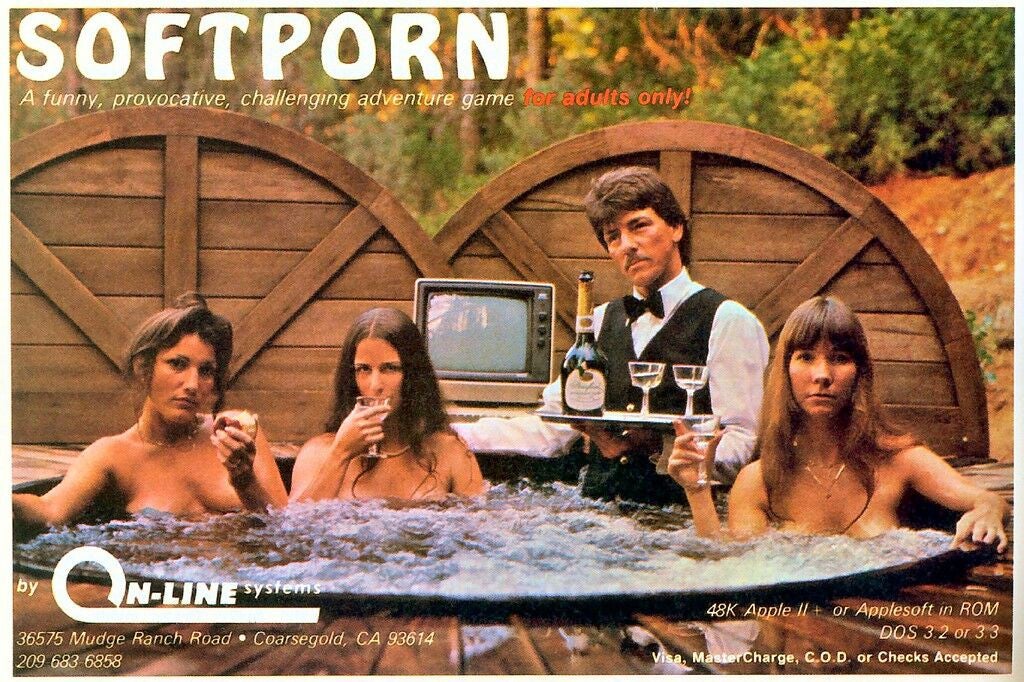
In his review in the 112-page (!!!) December/January issue of Antic (a magazine devoted solely to Atari products), Davey Saba wrote, “Since I am not interested in dragons or wizards (forgive me), Softporn is the way I spent my first adventure game dollars. It has been an unusual and entertaining experience.” An early Time magazine computer column, “Software for the Masses” featured a short blurb on the game in 1981 (right after mentioning a firm that was developing a program for a farmer to rate the productivity of cows): “I get a lot of phone calls from women asking when a female’s version of the game will be available,” Benton was quoted as saying in it. Unfortunately, that version never materialized.
Though the game was a success, Sierra later made a deal with Disney to create games based on their IP, and Softporn was quietly dropped for its somewhat-objectionable content.
The Incredibly Abbreviated Pitch
Sierra’s collaboration with Disney proved short-lived. The company soon realized that it’d probably make more money — and have more creative freedom — if it made its own games and split from the conglomerate. Sierra then began searching for their own IP. In the mid-1980s, Williams (who is currently sailing the high seas with his wife, renowned game designer Roberta Williams, and didn’t respond to requests for comment for this piece) remembered their first big hit, Softporn, and thought it might be worth remaking with graphics and sound. He asked Al Lowe, one of his designers, if he’d be interested in taking on the project.
Lowe took the game home to play through it again, to see if he thought the project was worth his time. As he explains: “A week later, I came back for a meeting and said, ‘This game is so out of touch, it should be wearing a leisure suit.’ A bunch of people in the room chuckled at that. I said, ‘I think the only way I could do it is make fun of it.’”
“To show you what condition the industry was in then, Ken said, ‘Go ahead and do it.’ That was the pitch meeting. ‘You think you can do something funny? Alright, go ahead.’”
How to Break Into the Game Industry in 1982
Lowe’s path into the gaming industry was unplanned, and mostly accidental, a pretty common narrative at the time. While working as a music teacher in Seattle, Lowe’s love of gadgets led him to purchasing a computer. He then taught himself how to program. “Then when the Apple II came out, I thought, Oh, I need one of those,” he says. “So I convinced my wife that we should spend a month of our combined salaries. Imagine. That’s what it cost.”
Eventually, he decided to try to create his own games, which were deeply influenced by the Sierra adventure games he played with his son, like Mystery House, King’s Quest: Quest for the Crown and Mission Asteroid. Lowe took his games to two computer shows, Computer Using Educators (CUE) and Applefest. They were a hit. A few publishers reached out, seeing if he’d want to make games for them. One of them was Sierra. He signed on as a freelance game designer.
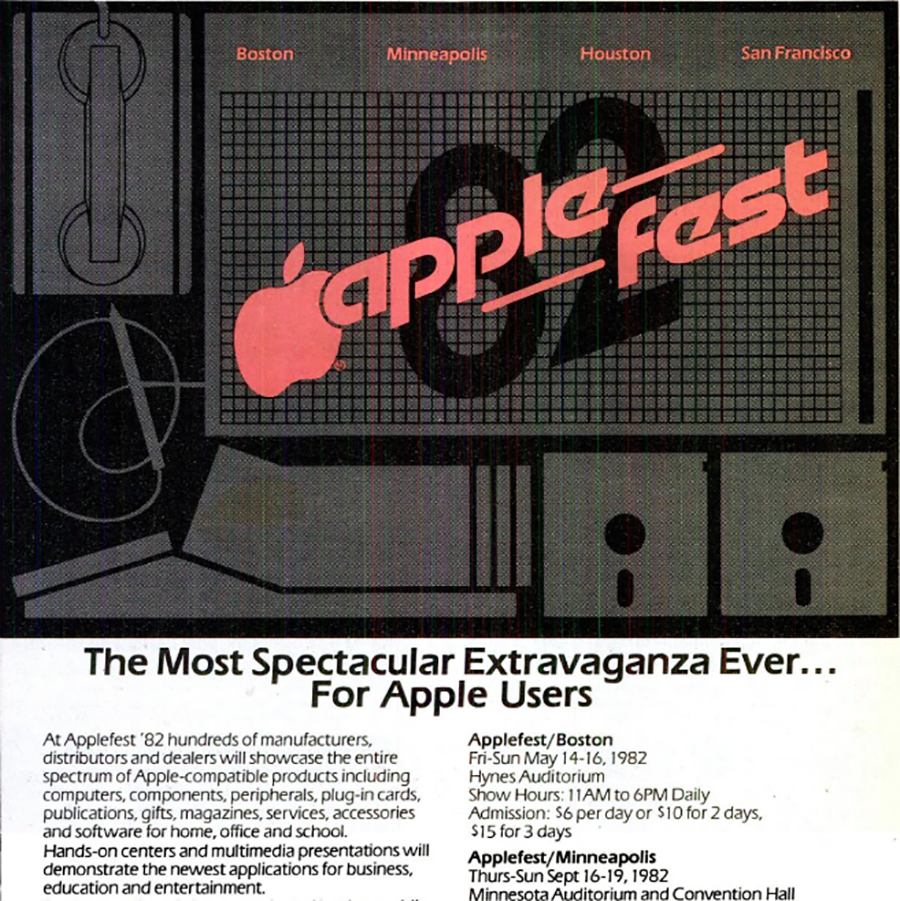
“Then after about a year or so, Ken recruited me to be a designer full time,” Lowe explains. “So I took a leave of absence from my school gig, and never went back.”
Larry Comes to Life
Making a game in the 1980s was difficult. Although the games were smaller, the tools to create them were nonexistent, limited or overly complicated. “[Larry] used an engine that Sierra created because there were no gaming engines, it used background images that were drawn with a graphics editor, because Photoshop hadn’t been invented yet. We’re talking Paleolithic period here,” Lowe says. “Sierra had a staff of people who worked on tools that created a background editor for background screens, an animation editor for animations, a music editor so we could put music in the games, a sound effects editor, a font editor — there were no font editors, we had to create our own fonts. It was just insane, when you think about that time.”
As he started brainstorming the game, Lowe figured he needed to humanize Softporn.
“There was no protagonist. There was no character development or any kind of conversation. It was an odd game. So the first thing I did was add a protagonist, and I thought, What could I do with this guy, what would be funny?”
He created Larry Laffer, a horny, leisure-suit-wearing putz. The character was partially based on guys he’d seen hustling women when he was a musician playing gigs at clubs in the 1970s. It was also loosely based on one of his coworkers. “We had one guy at the company who was on the sales team, and he’d love to tell all of us who had been stuck working in front of our computers about all the different women he had laid on his sales trips,” Lowe says. “I was like, ‘We don’t care, nobody cares.’”
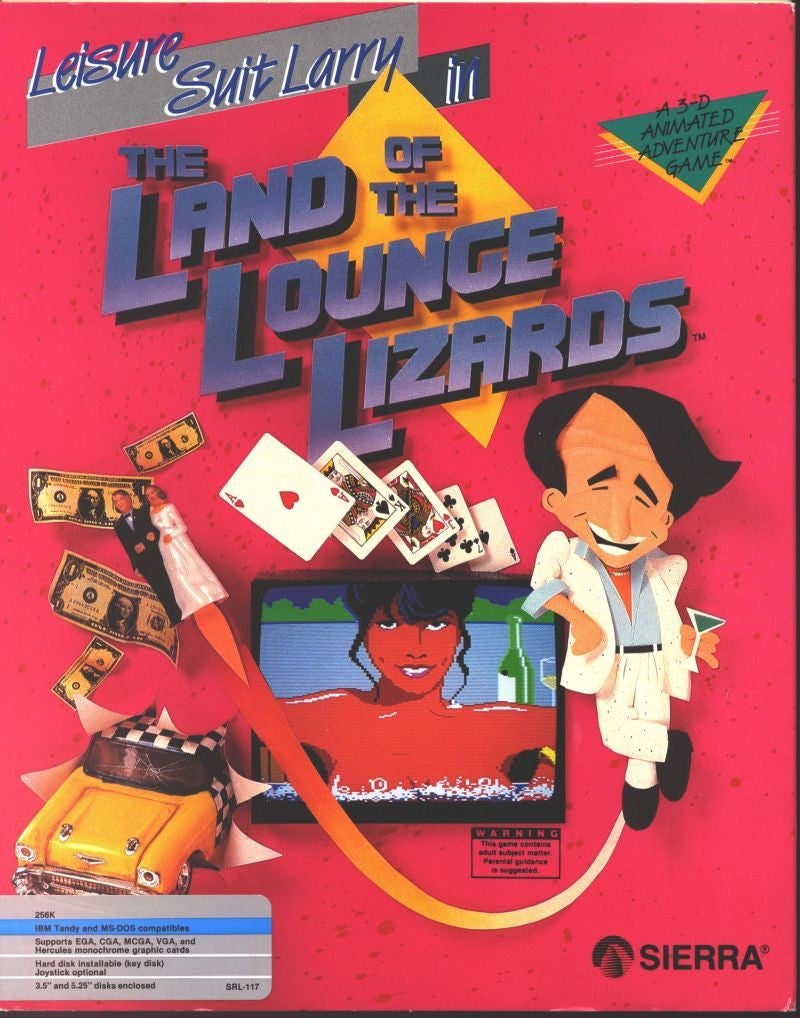
At the beginning of the game, Lowe added a quiz that players had to correctly work through in order to access the main story. It asked age-specific questions, like who recorded “Tiptoe Through the Tulips” and who Lee Harvey Oswald killed. “That was partly because Ken and I — well everybody back then — was into Trivial Pursuit,” Lowe says. “We thought it’d be fun to throw a trivia game at the beginning, and to show that we were at least trying to keep kids out, though I don’t think we succeeded in any way.”
It was easy to circumvent. “I wasn’t about to take a trivia test every time I tested the game, so I put a hot key in [alt-x] to bypass it. When we shipped it, we were like, ‘Eh let’s just leave it in, who cares?’”
While Lowe did almost all the work for the game himself, he still needed an artist to handle the animations and background screens. Of the four or so animators working at Sierra at the time, they chose recent high school grad Mark Crowe. Since he was already working full-time on Sierra’s other groundbreaking game, Space Quest, they arranged an incentive: The quicker he finished the game, the higher a percentage of royalties he’d get. Crowe worked on Larry on nights and weekends to try to make the deadline.
Despite the intense workload, there was also a tremendous amount of freedom in its creation. Lowe and Crowe added whatever they wanted to the game, with very little oversight. This included dark jokes, like Larry getting a radioactive STD if he didn’t use a condom. “Today, you’d have a team meeting, and you’d have to talk with the director, and have to go through the show runner, then the producers would have to figure out a budget for it,” Lowe says. “It’s such a huge industry now.”
Crowe managed to get the art done in about four weeks. “He got the big royalty rate,” Lowe says, “which really was disappointing [at first], because when the game finally shipped, it was the worst product in the history of the company.”
The Gold in That There Leisure Suit
When it first came out, Larry sold only 4,000 copies. It was a total flop. This was partially because of a general squeamishness regarding its potential offensiveness. The sales team at Sierra never presented it to RadioShack, which was about a third of their market. And other places were reluctant to sell it because of the game’s supposed adult themes.
Crowe went back to work finishing Space Quest, and Lowe joined the Police Quest team. “We kind of thought, Well, we screwed that up,” Lowe says. “We should’ve stuck with fantasy and swords and candles and crap.”
But over the next couple of months, Larry began to sell better. It had the same mystique as Softporn, but it was easier to play, more visually interesting and had a sense of humor. About a year later, it cracked the Top 10 on the sales chart. The sales were driven by word-of-mouth and widespread pirating, which boosted awareness of the game. “So many people pirated [Larry],” Lowe says. “At one point we sold more hint books than copies of the game.”
“I can’t tell you how many people I’ve met at shows or some other place, and when they find out that I wrote Larry, they say, ‘I’ve played that game!’” Lowe adds, laughing. “My next response is always, ‘Did you pay for it?’ Mostly they say, ‘I paid for some of the later ones.’”
The piracy became so widespread that bootleg copies of Larry became a reliable way to spread computer viruses. In late 1988, the New Accountant and the Financial Times reported that multiple banks and trading houses in Europe were hit with a virus that destroyed all the data on their terminals, after bored traders tried loading up illicit copies of the game. Sierra eventually had to respond to complaints that, no, official copies of the game were not going to destroy your computer and/or potentially bring down the global banking system.
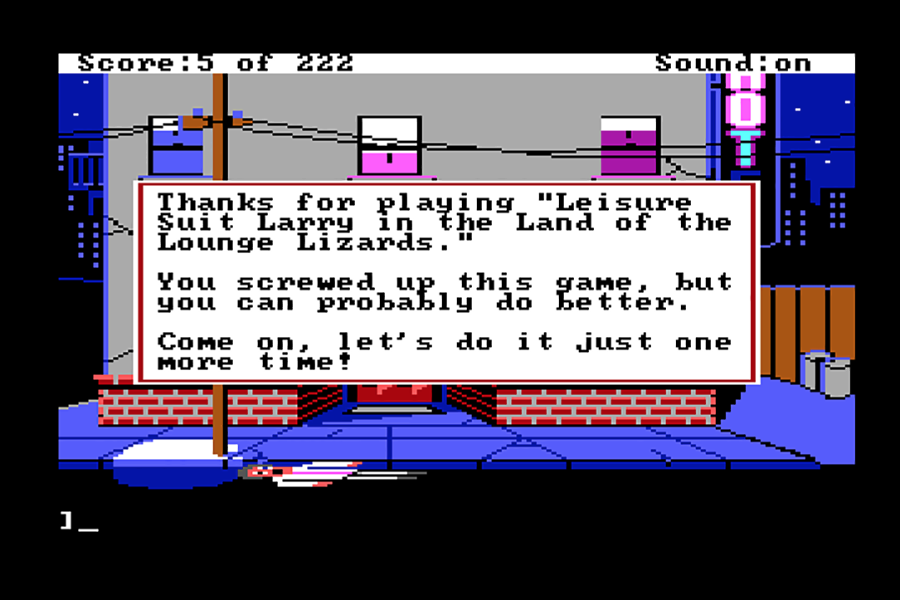
A year or so after its release, Larry had sold well enough that Sierra decided to make a series of sequels, becoming one of the most popular adventure games of the 1990s. “I’m pretty proud of the work that we did,” Lowe says. “I’d love to say all that stuff came to me in a flash and was part of the design and everything, but it was all very organic. “You make a thousand little decisions along the way, and when you’re done, it has to reflect the person that you are. I think that’s what happened.”
